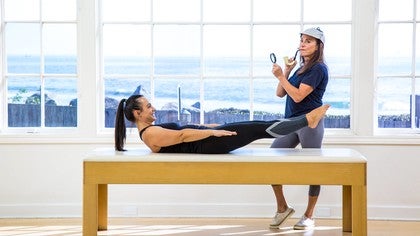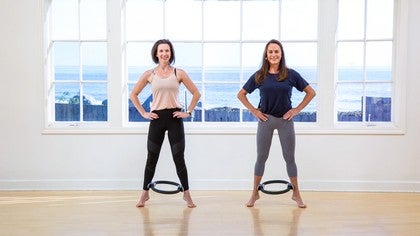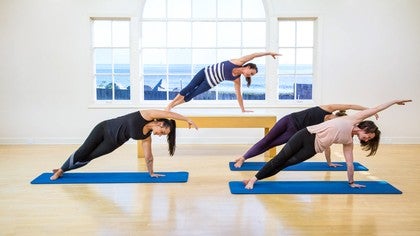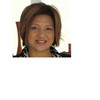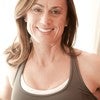Description
About This Video
Transcript
Read Full Transcript
Hi, welcome to the discovery series. My name is Claire Dunphy Hamani and today we are going to discover where are the hundreds shows up in all of these unexpected places. So hang on, I think you're in for a fun ride. Joining me today is Anna. Hi Anna. And um, you know, the hundred is really interesting because it reveals so much about where we are in terms of balancing the strength in our two way stretch. And so I think of the two way stretch and feel it in my body as where my legs are reaching out of my lower back and my arms are reaching out from behind the back ribs in every single position in every single exercise.
And the more I can hone in on that, the deeper and the more I get out of the exercises. So it's really interesting because I think that when you can visualize a position that you pass through, either on the way up or on the way down or in the midst of whatever movement that you're doing, when you can capture that shot as an image of what you want your body to do, your movements are consistently more, more better. How's that for my English? So I'm going to just take off my hat now and my glasses as we go into our discovery here. And we're going to start.
So the weight of the head is right off and inside. Can you see how gorgeous that position is? Can you reach a little longer? That's it. She just tightened into it a little bit more. Now can you pull into it a little bit more from the front and lengthen out of the back? You've got it and a little bit more and then bend your knees in and relax.
So this is the position that we're looking at, and I don't know, I've been doing PyLadies now for 25 years ish. The a hundred never gets easier. It's one of those exercises that the more you do it, the more you discover, the more you find, the more reach you find. And that's the brilliance I think, of the Palati system in general. So we don't get complacent and say, okay, I'm here. There we go. No, I'm like, I go further. I go further. I find more. I find more. And this is what makes your body feel so great at the end of it. I mean, after all Joe said, in 10 sessions, you'll feel better. In 20 sessions, you'll, you'll, you'll look better. And in 30 sessions you're going to have a new body. Well, you're not gonna have a new body without finding your edges.
And so that's kind of what we're going to be looking at today. So let's just take that position and if we turned it on its head or on its side, let's see all the different places where we see it. And so the next x exercise is going to be the overhead. I got your spring for you. So the overhead and when we see it on the mat, it's going to be the same as the Jackknife is that same shape in space that we're trying to go for. So you're not even warmed up. She's a good sport.
So let's go ahead and pull on the straps and go over and then go up. Push, push up even more. There you go. So you can see that upper body position. You can see the legs reaching out of the low back. You can see the arms reaching. Now go ahead and slowly roll down and reach and reach and reach and return all the way. So we have it in that position as well. And the interesting thing is, is so when you're working with somebody, cause that's a pretty advanced exercise, the overhead and the Jack. Nice.
But if I'm watching somebody perform the, the um, hundred and let's just go back to the a hundred position again and let's say that their, their lower body
If the upper part is having a weakness and they can't quite get into their upper abdominal curl and they can't quite get their heads up and their arms are kind of not really reaching, then I know where my session is gonna lead me. So that's why I feel like the brilliance of seeing that very basic position right from the first exercise. Well in the, in the reformer, it's the second exercise, but it's like the first exercise we get to see which reveals all this information, which informs how you're going to help them. So they feel better when they leave and progress over time. So let's go on in the water and go to the rowing. So come around and you can grab your handles and we'll go to one inside spring.
Okay. So the rowing series, the very first part of the exercise is critical because it brings into play the, the dynamics of the hundred. Okay. So go ahead and pull into your sternum. So the weight of the heads going forward, stay there, wait a minute, stay there. This is all coming under and reaching. That's it. Without losing this. And then come all the way up again. Okay. So I'm sorry to stop you in the middle, but that's what's happening in the body. It's not just we lean back, it's like, no, I'm reaching and my upper body is curling.
So she goes and she reaches in cold into it, open to the side, pull back oopsies you're, you're caught. And go over and then stretch
And bring yourself up.
So go ahead and stretch up open and pull forward and around close. Okay, great. You see the a hundred there, push out, touch my arm, reach with your fingertips there she goes. Now pull back in a way, no reach, reach, come in so you can see her dialing in. Do it again, stretch open and, and go ahead, go bigger, go big, go reaching. Awe. Can you see that? Can you hold it there? Are you wrapping around here? Are you stretching out? Touch me with your feet. Go ahead and come in.
So this is what we're talking about. And then you only have to do three good ones. Your body's going to change in 30 sessions, right? Let's take out a spring and look now at the, um, at the teaser because the teaser, the roll up, as you'll see, um, we pass through the position of the hundred both on the way up and on the way down. So if you can see that shape and go for it, it's a game changer. So let's get this wrapped around. Everything's pulled together. All right, lift up your head, look at me and come up. Okay, good. That's it. Good. Try. Reach up, reach up and out. Reach up and out.
There you go. So she's up and where we could do arm circles and we can lift and lowers. We're not, we're going to concentrate on coming down. So go ahead and roll down and you're going to pass through the position of a hundred on the way down. So roll the hips under. You. Keep reaching out of your low back and out of your back. See it.
There's the a hundred and come all the way down and it's, it just helps people because often if you let, can you show it. If you dropped your arms too soon or dropped your upper back too soon. So come up, just come, comes to your teaser. Let's get you here. Reach up and out that to grow higher. Touch me, come on, lift your back. Gotcha. Oopsies squeezes together. All right, now go on down but let your arms fall down too soon. Kind of fall.
Yeah. You know, or people have a bumpy upper coming down or bumpy coming up and it really just helps it. Like the a hundred is an exercise. It's a familiar exercise no matter what school you're trained in, it doesn't matter. We all know the hundred. I would call that a unifying exercise amongst all of our styles of polities, but we can use it to help anchor certain certain aspects of an exercise that might be bumpy. And coming down on the teaser I find is a really important place to see that. So now a step off and we're going to keep going through this tutorial and look at the up stretch.
Okay, so we are going to be on two springs foot bar up. Okay. So, and there's only one aspect of the exercise, but I love it because you know in the hundred when your head is up and you're reaching, the upper back is wide near the shoulder blades aren't pinched together, the head isn't lifting up. You know everything's a nice straight, long line down below. And a nice upper curl up above. So, so we're going to go to the up stretch. So lift your hips and you don't bring it up. There you go. So of course this was coming after those, the other exercises and this is all going to be lifted towards the ceiling.
Nice and high. There's that part of the two way stretch. There's this part of the two way stretch and everything in the middle is going up. Alright, so now go ahead and push out, curl the hips under and forward. There you go. And come in. Do you see the hundred? Keep going, keep going. Keep the hundred and then you pull back in half and then go ahead out, come under and forward with it. Oopsies come under fourth, then pull it in.
So [inaudible] get it in first and then lift up. Got her out under it. Squeeze it all in. There is the hundred and finish there. You see? See what I mean? It's like if you can visualize it, then you don't like miss that little piece of the exercise where your body wants to give up because that's where we start to get stronger. So now we're going to go right from the stay there.
Print from the up stretch and walk your feet all the way up here. Who are going to go? Knees off, knee stretches, knees off. Okay, so bend your knees down, tail under you here. Hips back here. So where the a hundred lives is now when she kicks back. So push man, push out and hold it there for a second. Push out, get your tail under you. Well No, let's just stay there. Just stretch your legs. There you go. You see the hundred and pull in. Now go for it.
And in and in. Keep this under in. Keep that up in, get this under you in get this Sunday. So that's where we need to work with her right in and step down. Great. And everybody's body has a different thing that they do depending on whether this is the weaker part of their two way action or this is the part of the way, the ones that are weaker in the upper part, they tend to kind of collapse down here and keep their booty in the air, right? So, but it helps, right? When you see that ax, that picture, you don't, oh, that's what I'm going for. And you can stretch into it.
You can really work into it. Now moving right along, let's see where the hundred shows. The a hundred position shows up in the front splits, shall we? So why don't we put your left foot up on your right foot up on the bar so your left leg is out.
All right,
But instead it's really about getting pulled in. Now lift your ribs up on this side. Push into your arms, pull this up, pull this under. That feels good, right? There's your stretch. Now she's gonna push out. You see there's that shape. There's that line again. Reach with your arms. There you go. And come in and go out. That's beautiful.
Feels good too, right? Hold it around and come in, in, in, and then relax. Alright, come down. Okay, so you're getting the sense of that position, um, in the different reformer exercises. And I feel like as a teacher, when I see that it helps me be able to, in a very simple way, you know, work with somebody to help them own the position and feel like, oh, I can go deeper into that. Cause I understand the hundred, which is one of our anchoring exercises. So, okay. So we're going to now segue over to the mat. Okay, so continuing on with where are the hundred shows up in exercises. We're going to be looking at some of the mat exercises.
So of course we have the hundreds. So let's just come into the position of the hundred just to reiterate what we're looking at. Cause it, it might be a little different than how you might be looking at it. So the arms, can you raise your arms to the ceiling? The idea that when the head lifts and the arms reach, they're pulling the spine up and out and when the legs lift, they're actually reaching and pulling the spine up and out in the opposite direction so that we have this wonderful thing called opposition and that's what makes movement and [inaudible] work in the body in this magical, magical, wonderful way. It's just a matter of finding it in every exercise and figuring out how to help other people get a good balance between the strength of each of those areas.
And there could be a variety of things that's restricting the ability to maximize the position. And that's our job as a team, as a detective is to discover, well is it the neck is tight or is it that the, is it the lower back is stiff, is what is happening in there. And this, if we can work through the system, it does work all those places out. And um, to simplify things, because I think keeping things simple as hell, we, we get people to, where we want to go is just to give them the simple like this. So let's just look at the hundred again, the position of the hundred. So she lifts up into the reach and she's reaching her legs and she's reaching her arms. And from that position, the whole entire ab series is born.
So we already reviewed the hundred. So now just take your knee into your chest, like you're doing a single leg stretch. All of this stays the same. Change legs, all of this is staying the same. Go to the double leg stretch. So reach and then come in, hold to your ankles and then reach. Go ahead out. The arms are reaching out and come around in.
Let's go to the single straight leg. Stretch this position, grab your ankle.
But that's what we're working towards. And then we'll go to the criss cross criss cross. So she's keeping the shape of the hundred and relax throughout the entire ab series. And so everybody's body's a little different. You know, often people will start to lose it in their upper self and their upper body and they start to drop their head or their shoulders or something's happening in their lower body. And our mission is to find the equal, equal opposite. So now we're going to look at the role up and where the hundreds shows up here. So take your arms up to the ceiling
But here's so many ways that we throw it away. Bring your head up over your shoulders. So she's going to come right in here.
So the roll up shows up often it shows up in countless transitions on the mat, but it also shows up in the wall. It also can you come to a standing position? It shows up even when we're, um, when we, when we're rolling down for our chair exercises. So if you can stand sideways for me and reach your arms up to the ceiling, it shows up in how we come down the pushups. And this is one of my recent sort of pet peeves because I see it in dance class all the time.
I studied Luigi style of dance and we [inaudible] do a lot of rolling down in, rolling up and often people just kind of going down without like articulating and feeling that whole rolling experience. So if you can imagine there's a wall down the back of Anna and she's going to roll down that walk. Go ahead, take your arms, take your head. I'm not going to let her bring her her, but behind her, she's curling down. She's lifting her back up in over to come down and now curl up. So that's the same as your roll up.
That's right there on the mat. And the other point that I just want to kind of bring up is that, do you know how a go a water spout is? The water goes up like a fountain, it goes up and it goes like that. So when you're rolling down the word down can be misleading. You're actually want to think of sliding your back up as it goes over.
So I'll be the wall and she's here and go ahead and bring your chin to your chest and actually slide your spine up towards the ceiling up. So this is going up to go over. That's far enough and come up again and roll yourself all the way up. So every opportunity we have to roll up and down in a transition or to do the wall or any of the chair exercises for that matter, it's all a part of it. It's all an opportunity to practice that.
So, um, let's go to two other, the size is where the hundreds shows up unexpectedly. And the first one's going to be the net pool. All right, so flex your feet. I'll be your strap. Okay, so separate. Okay. All right. So this is happening down below, through the back of the body. It's not about bunching all of this up. So really get this happening.
Reached through the heels and then the head comes up. Wait, there you go. There's the a hundred but keep that long and she goes over beautiful. And then curl up from the base of the spine and now she rolls back and she'll pass through the position of the a hundred on the way down. So this is [inaudible] I'm going to come along and under, this is still pulling over. It's just deliciousness all the way around.
You do not have to hate it. Yeah, this exercise. Okay, let's move on to the Jackknife Challis. So bring your legs together and this is going to be very similar to the overhead, but you'll see the position of the head and see the position of the spine. Now an unexpected reach of the arms will enhance that whole two-way dynamic. So stretch your legs to the ceiling and let's do the Jackknife over and up. Reach your arms, bring closer together. Welcome in, welcome in. That's it. Do you see the a hundred if we took a snapshot and then go ahead and roll it out. Reaching, reaching, reaching, and reaching.
Okay, so bring your hands in a little closer. There you go. Anchor them there. Cause this is going to help you get more of a stretch around your back and do it one more time. Go ahead. Over and up. It's a discovery. Don't forget there's no right and wrong here. Reach. Reach into your arms. Pretend somebody's pulling them and let's start to come down.
Okay, so the challenge for her was, wow, what happened when I had her arms and closer so we have a little clue. It's like, oh, we got a little strength more to balance that out. And it's all good because when we discover areas in our body that need attention and we give it that love and attention, all of our movements get better. So, um, yeah, so you'll join us when we do the mat class. We're, all of these things will, will show up, but for now we're going to go and look at some of these ideas on the one two chair. Okay. So we're back again with the chair and we're going to take a look at the teaser and how the teaser plays out in, um, the shape of the hundred and specifically how you work, the reach of the pedal and the weight of the head so that we don't just fall back. But how it really does come from the powerhouse.
This is one of my favorite exercises. I know for me, my, I, I was very ready. I was like really way out here when I first started my plebes practice. And this was one of the exercises that really helped me get this, this lengthening through my arms, out of my back and it, and it would surprise me that this was the exercise that did the trick for me. So, um, the way I'd like to set up for the teaser, um, is to hold onto the front of the chair to kind of rock back and bring your knees into your chest. Like you're doing stomach massage, so you're already rocked back a little bit. And then go ahead and take your legs up to the teaser and your arms up to the teaser. And there you go.
Now bring your hands by your sides and bring your hands on the pedal. Fingers in first. Right now. Good. Take your Chin into your chest. So you're here. So the spring is closed. Her weight of our head is forward. Now before you even start going back with your body, push into the springs and unlock the springs. Do you feel what you just did there? That's the secret.
Now she's going to keep reaching back while she keeps the weight of her head on the inside and go down and push the push the spring away. And our feet are going to come just to here. Press there. Do you see the shape of the a hundred and then we come up again, reach into the pedal, lead with your head and you bring it up. You can keep your hands back there for a minute. Okay, so let's go do that again. So she's staying in her teaser and she's gonna Unload. Lock the spring first, but not move her body. Push into it, and then go ahead and reach from there.
Okay, so go, go, go, go, go, go, go. So she's got to use this part of her two way. Stretch that part. Now pump the pedal three times off the back. The back is flat and long, not arched. Two and three. Now keep reaching into the pedal and lead with your head and come up. Close the spring. Close the spring first. Then reach out for your teaser.
Come on, touch your toes, grab my arm, lift your back, lift it. That's it. Hold it. You got it. Hope got it. Got It. And you gotta stand up. Great. But you see where the teaser Liz there and it's that little bit of like the I the idea that you're really holding the weight of the head and then reaching back at the same time. So they feel great like in your back. Yes. So, so there is how you can play with that position in that shape even in the context of that exercise. So let's now look at, let's see, I'll change the springs.
We have two 202 other exercises and I'm sure there's a lot more that you guys are going to think of as you're practicing. But let's go ahead and look at the sh the shape in the position of the mountain climb. So we're going to change the springs and we're going from on top and one bottom.
Okay. So we're going to have your fingers here to start. So think of that position again. So then this isn't just like a, like a random shape. We want the weight of the head in. We want this strongly pulling up at this section of the body, this strongly lengthening on that section of the body. And then you're just going to take your hip up to the height of your knee, just a little. And from there we pump one, two, three, four, five, six, seven. And stay. Get this under you a little bit more.
Get this up a little bit more. Can you see the shape and the position? Good and relaxed. So it's, it's just these little ways that we get to see the shape again, that tightens that up, puts it right into the perspective of the two way action in the body. So let's take that same shape and look at the pullup neck. Alright, so we'll take your hands out to the cutout and bring him in at shoulder distance apart. Okay. And pull up into here. Just lift up into my hand here.
Pull this under here. So we have again this length. Okay, that's it. Go ahead and bring the pedal up. Come up, come up, come up, come up, come up and lower down from here. Curl the tail under and we'd go up again, the weight of the head in, you got an n, you got the carriage clothes. Can you stay there for a sec? Pull up, pull up, pull up. Now to lower the pedal, we want the peddle to lower from there because that's where her legs attach in our imagination. Curl under your tailbone, curl it, go, go, go, go, go, go, go, go, go, go, go. And then step back. [inaudible]. So in this way we get to say, Gosh, you know, let's take a challenging exercise and say, wow, where do I need a little bit more work? Where do I need a little bit more work?
And that's how I see the hundred throughout those three pieces of apparatus. So it's a discovery, have fun with it. And, um, I'm curious to see what else you got. Right when you're looking at the a hundred shapes in different exercises.
The Teacher's Corner: The Discovery Series
Comments
You need to be a subscriber to post a comment.
Please Log In or Create an Account to start your free trial.
